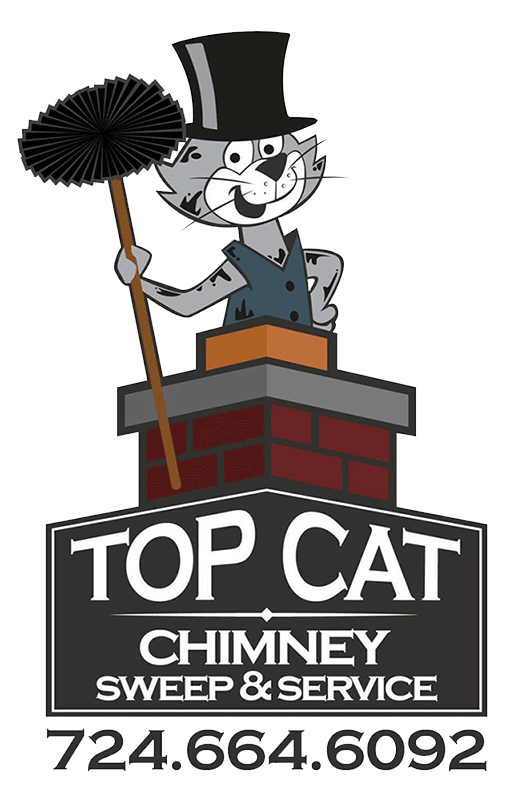Pittsburgh homeowners trust Top Cat Chimney for reliable chimney services year-round. Cold weather brings its fair share of challenges, and your chimney is no exception. Ignoring chimney maintenance during the winter months can lead to pricey fireplace repairs, lowered efficiency, and potential safety hazards. We aim to keep your chimney operating at peak performance, allowing you to enjoy those cozy fires without worry.
If you’re experiencing chimney trouble or you’re overdue for your next chimney inspection, call Top Cat Chimney today at 724-952-2761 or contact us online.
Can Snow & Ice Cause Chimney Damage?
Snow and ice may seem harmless, but they can wreak havoc on a chimney. Prolonged exposure to moisture causes masonry to deteriorate. As snow melts and refreezes, water seeps into small cracks and expands, causing further damage. This process, known as the freeze-thaw cycle, can lead to spalling bricks, crumbling mortar, and structural instability. Even metal components, like flashing and chimney caps, can rust or shift out of place after heavy snowfall.
Another often overlooked issue is the weight of accumulated snow. While most chimneys can handle moderate loads, excessive buildup can strain the structure, especially if pre-existing weaknesses exist. Pittsburgh winters are unpredictable, so it’s crucial to monitor your chimney and call in professionals at the first sign of damage.
Is It Safe to Use My Fireplace When My Chimney Is Covered in Snow?
Lighting a fire with a snow-covered chimney might seem safe – even helpful – at first glance, but it can create serious risks. Snow and ice blockages prevent smoke and harmful gases from venting properly. This can force carbon monoxide back into your home, putting your household at risk. Even partial blockages disrupt airflow, causing poor combustion and excessive creosote buildup, which increases the chance of a chimney fire.
There’s also the potential for falling ice. Snow and icicles can break loose from the chimney and crash down onto your roof, damaging shingles or gutters. If your chimney’s structural integrity is already compromised, the heat from a roaring fire could exacerbate existing cracks or weaknesses.
Rather than guessing if it’s safe, consult with a chimney expert from Top Cat Chimney. A quick assessment can determine whether your chimney is clear and ready for use.
Should I Cover My Chimney in the Winter?

Contrary to what some might assume, completely covering your chimney during winter months is not recommended if you plan to use your fireplace. Your chimney requires proper ventilation to function safely. However, certain protective measures make sense for specific situations.
If your fireplace remains completely unused throughout winter, a custom-fitted chimney cover might help prevent excess water intrusion, animal entry, and debris accumulation. These covers differ from standard chimney caps by completely sealing the opening, making them suitable only for non-operational systems.
For active fireplaces, the better approach includes:
- Installing a quality chimney cap with adequate overhang to direct water away from the flue
- Adding a top-mounted damper that provides a tight seal when not in use
- Considering a chimney cricket for chimneys built against sloped roofs where snow and water collect
One of our knowledgeable chimney technicians can recommend the right combination of protective elements based on your specific chimney design, roof configuration, and usage patterns. These recommendations balance ventilation needs with appropriate winter protection.
How Can I Prevent Snow & Ice Buildup on My Chimney?
Winter chimney maintenance starts with proactive measures. Scheduling a professional chimney inspection with Top Cat Chimney before temperatures drop is the best defense against cold-weather issues. Our trained technicians can spot early signs of wear, recommend repairs, and advise on preventative solutions.
Installing a quality chimney cap is one of the most effective ways to block snow intrusion. Waterproof sealants can also be applied to masonry, reducing water absorption without trapping moisture inside. This treatment helps your chimney withstand Pittsburgh’s harsh freeze-thaw cycles.
Regularly clearing snow from your roof prevents heavy buildup around the chimney. However, climbing onto an icy roof is dangerous and best left to professionals. Heated cables are another option, reducing ice formation along the roofline and around chimney structures.
Proper flashing installation is equally crucial. Damaged or poorly fitted flashing allows water to seep into your home, causing leaks and interior damage. Our experienced team can assess your current flashing and make necessary adjustments to keep your chimney watertight.
Stay Warmer, Stay Safer: Trust Our Experts Today
For nearly two decades, Pittsburgh homeowners have counted on Top Cat Chimney for thorough chimney inspections, expert repairs, and long-lasting solutions that keep their fireplaces and chimneys running safer all season long. Regular maintenance isn’t just about comfort – it’s about protecting your home and loved ones.
Let us handle the hard work while you enjoy a warmer, worry-free winter. Call Top Cat Chimney today at 724-952-2761 or click here to schedule your chimney inspection and get ahead of the season’s challenges.
